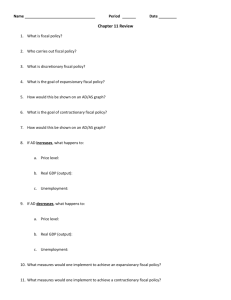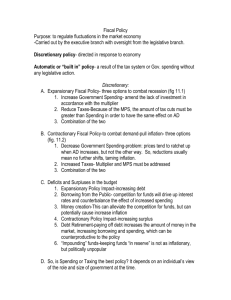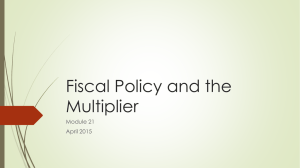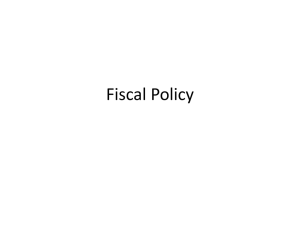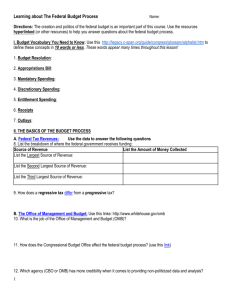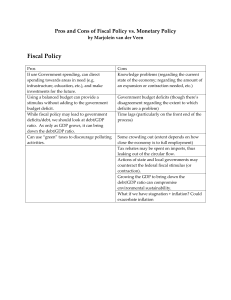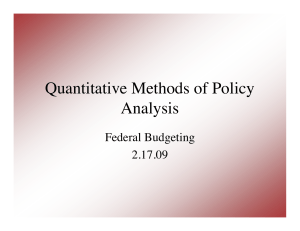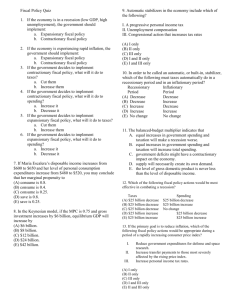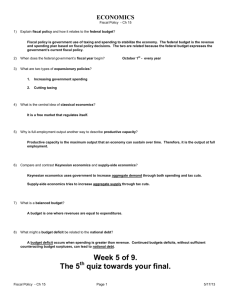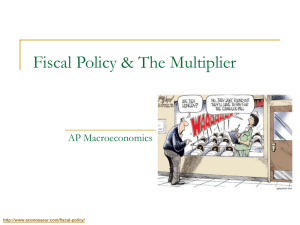Fiscal Policy
advertisement
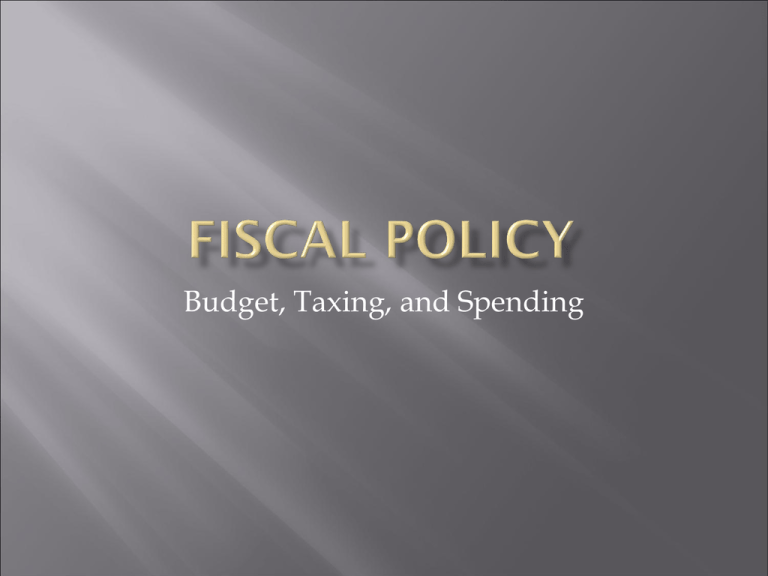
Budget, Taxing, and Spending Government has a major influence in macroeconomic policy. 2010= $2.1 Trillion received (Revenue) 2010= $3.5 Trillion spent (Expenditures) Fiscal Policy is the method of taxing and spending used by the Government to help reach our macroeconomic goals. Fiscal Policy Tools: 1) 2) Spending Taxing How does the Government spend $3.5 Trillion? How does the Government collect its revenue? Federal- Income Tax, Corporate Income Tax, Estate Tax, Gift Tax, Tariffs State- Sales Tax, Income Tax, State Fees and Registrations, State Lottery Local- Property Taxes, Local (City, County, or Township) Fees Tax Structures Progressive Taxes- Tax structure where the percentage paid in taxes increases as income increases. Regressive Taxes- Tax structure where the percentage paid in taxes decreases as income increases. Ex. Income Tax Ex. Sales Tax Proportional Tax- Tax structure where the percentage paid in taxes is the same for all income levels. Ex. Flat Tax April 15 Report income from employers (1040 form), the 1040 form helps taxpayers find out their taxable income. Taxable income= Gross income- exemptions and deductions IRS determines how much you have paid in taxes and how much you owe, or overpaid. The amount that an individual owes is dependent upon their taxable income. Budget Process- Surplus, Deficit, or Balanced 1. Office of Management and Budget (OMB) i. Works with the President to put together a draft of the budget. 2. Congress i. Reviews the budget draft and makes changes 3. President i. Signs the budget or Veto’s the budget Discretionary vs. Mandatory Discretionary- Money that policymakers get to decide on how or how much to spend. Ex. Defense, Education, Environmental Research, Foreign Aid Mandatory- Money that is determined by law to fund certain programs or Government functions. Ex. Social Security, Medicare, Medicaid, Interest on Debt Expansionary vs. Contractionary Expansionary Policy- Increase Spending, Decrease Taxes, Increase in Government Transfers Used to Stimulate the economy during a recession Contractionary Policy- Decrease Spending, Increase Taxes, Decrease in Government Transfers Used to slow growth during an inflationary BOOM Government Spending Multiplier= 1/mps, this gives us the max that an increase in spending can boost GDP. Tax Multiplier= mpc/mps, this gives us the max that a decrease in taxes can boost GDP. Why is the Tax Multiplier smaller than the Spending Multiplier? a. Draw a correctly labeled graph showing an economy experiencing a recessionary gap. b. What type of fiscal policy is appropriate in this situation? c. Give an example of what the government could do to implement the type of policy you listed in part b. d. GDP is $200 billion below potential output, how much would the Government have to cut taxes with a MPC=.8, to bring the economy to full-employment? Programs that automatically help to counteract cyclical change in the economy without any legislative action. Unemployment Compensation Corporate Profit Tax Progressive Income Tax What is happening with these programs during a recessionary gap or inflationary gap? As GDP Changes: The automatic stabilizers change… Progressive Income Tax- decreases as GDP decreases… And increases as GDP increases The Effects: This automatic change will slow down an economy in expansion, and stimulate an economy in recession. No legislative action… enough said! Timing is everything: Policy lag is the delay that it takes for a policy to start impacting the economy. Forecasting lag is the delay that it takes for policymakers to figure out what policy to implement. Fiscal Policy that is changed by policymakers when the business cycles change. What can policymakers change? Education, Military, Agriculture, Transportation When would discretionary fiscal policy be used? Proper Timing of discretionary spending is both difficult to achieve and crucially important. Good Timing= Properly stabilized business cycle change Bad Timing= Unnecessary business cycle fluctuation Automatic Stabilizers help to balance the economy without legislative action, but they lack any potency to rectify a severely struggling economy. Fiscal policy doesn’t impact the economy as much as initially presumed. Lessened Multiplier Effect Political Considerations of Fiscal Policy: Fiscal policy is created in a political arena What problems could this cause? Politicians have an agenda that doesn’t always match the need of the economy. Politicians are worried about getting elected, and certain fiscal policy options are not popular with the public. Budget Surplus vs. Budget Deficit Surplus= Contractionary Policy Deficit= Expansionary Policy Should the budget be balanced? Problems of prolonged deficits: Increased Public or National Debt Problems with a forced balanced budget: Lessens impact of fiscal policy ability Problems with the rising National Debt: Crowding Out Effect: As the Gov. borrows money, it pushes up interest rates and discourages or crowds out business investment. Show Loanable Funds Market Graph Also, as our public debt increases more of our government spending is needed to pay back interest on our debt. The payments on the interest limit the gov.’ s ability to spend on other needed areas.
